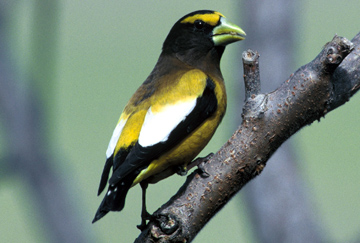U.S. bird populations plummet
U.S. bird populations plummet
Rhett A. Butler, mongabay.com
June 14, 2007
Populations of some of America’s most common birds have plummeted over the past forty years, reports a new analysis by the National Audubon Society. Some species have seen a decline of 80 percent.
The study, which combines the National Audubon Society’s Christmas Bird Count with summertime surveys by the U.S. Geological Survey, found California species were particularly affected, with populations declines of 75 to 96 percent for several species, including the Northern Pintail, Horned Lark, and Loggerhead Shrike.
The National Audubon Society attributes the decline to loss of habitat, especially grasslands, forests and wetlands to urban sprawl, energy development, and industrialized agriculture. The group warns that climate change could compound losses in the future.

Evening Grosbeak. Photo by Dave Menke of the U.S. Fish and Wildlife Service |
“These are not rare or exotic birds we’re talking about—these are the birds that visit our feeders and congregate at nearby lakes and seashores and yet they are disappearing day by day,” said Audubon Chairperson and former EPA Administrator, Carol Browner. “Their decline tells us we have serious work to do, from protecting local habitats to addressing the huge threats from global warming.”
All the species on Audubon’s list of 20 Common Birds in Decline have seen their populations plummet at least 54 percent since 1967. Nationwide, the hardest hit were the Northern Bobwhite (82 percent decline), Evening Grosbeaks (78 percent), Northern Pintail (78 percent), and Greater Scaup (75 percent). The charismatic Rufous Hummingbird saw its population fall 58 percent.
The National Audubon Society said agricultural and development pressures have driven grassland birds to the worst declines.

Evening Grosbeak. Photo by Howard B. Eskin |
“Direct habitat loss continues to be a leading cause for concern,” said Audubon Bird Conservation Director and analysis author, Dr. Greg Butcher. “But now we’re seeing the added impact of large-scale environmental problems and policies.”
“People who care about the birds and about human quality of life need to get involved in habitat protection at home, in pushing for better state and national protections and in making changes in their daily routines,” he added.
The National Audubon Society says habitat protection through sound agricultural policy, sustainable forest use, and wetland conservation is the most important step to protecting bird species. It notes that combating invasive species and reducing global warming emissions and pollution will also help America’s bird populations.
A study published earlier this month in PLoS Biology warned that climate change and habitat destruction could cause the extinction of 10-20 percent of terrestrial bird species by 2100. Similar figures were put forth by researchers in a paper published in The Proceedings of the National Academy of Sciences last year.
Related articles
10-20% of birds extinct by 2100 due to global warming, deforestation. Ten to twenty percent of the world’s terrestrial bird species could be threatened with extinction by 2100 due to climate change and habitat destruction reports a study published in the June 5 issue of the journal PLoS Biology. The numbers are in line with estimates published last year in The Proceedings of the National Academy of Sciences.
1250 bird species may be extinct by 2100. Two new studies paint a mixed future for the world’s bird populations, one suggesting that 12 percent of existing species could be extinct by 2100 and the other finding shifts in migration patterns among birds that migrate long distances. Researchers at Stanford University, Duke University and the Missouri Botanical Garden in St. Louis examined the extinction record for birds and found that scientists have likely underestimated the number of extinctions. Until now, scientists has documented the extinction of about 130 bird species since 1500 but the new research, published in Proceedings of the National Academy of Sciences, argues that the actual number is closer to 500, indicating an extinction rate of about a bird species per year. The scientists warn that this rate could climb to five species per year before the century ends, impoverishing earth of some 1250 species of birds.
Biodiversity extinction crisis looms says renowned biologist. While there is considerable debate over the scale at which biodiversity extinction is occurring, there is little doubt we are presently in an age where species loss is well above the established biological norm. Extinction has certainly occurred in the past, and in fact, it is the fate of all species, but today the rate appears to be at least 100 times the background rate of one species per million per year and may be headed towards a magnitude thousands of times greater. Few people know more about extinction than Dr. Peter Raven, director of the Missouri Botanical Garden. He is the author of hundreds of scientific papers and books, and has an encyclopedic list of achievements and accolades from a lifetime of biological research. These make him one of the world’s preeminent biodiversity experts. He is also extremely worried about the present biodiversity crisis, one that has been termed the sixth great extinction.














